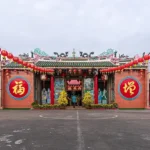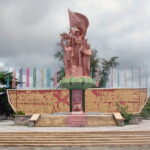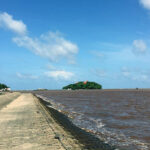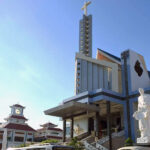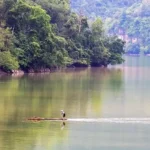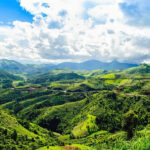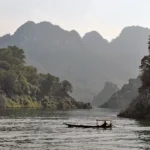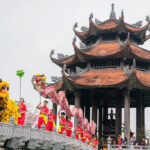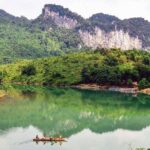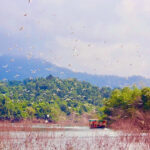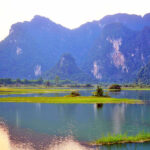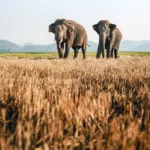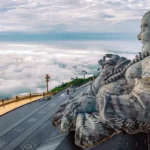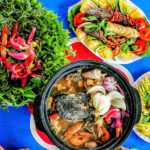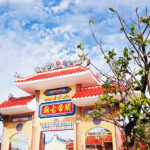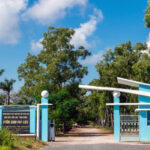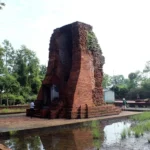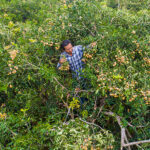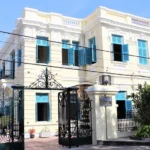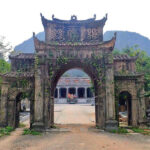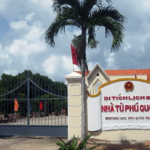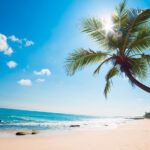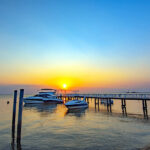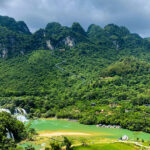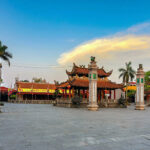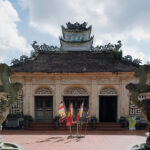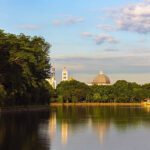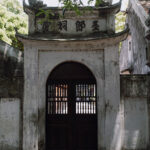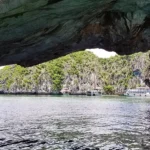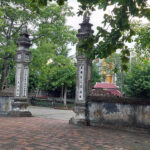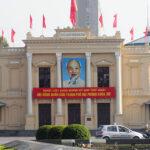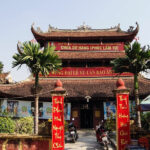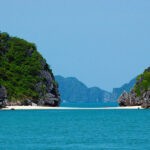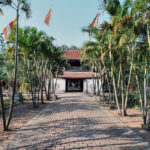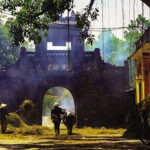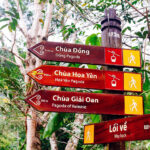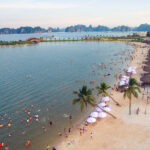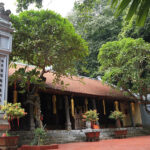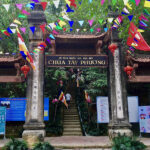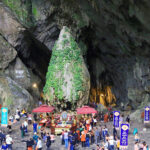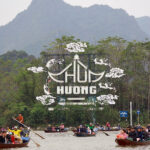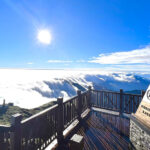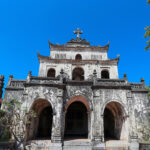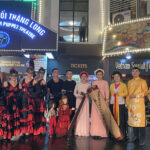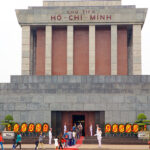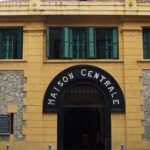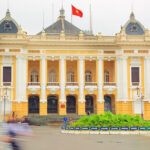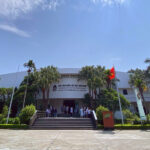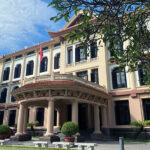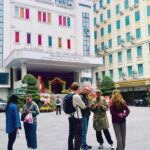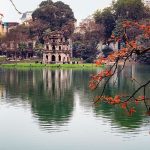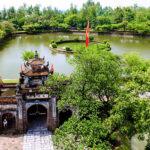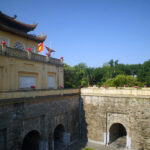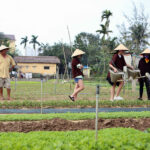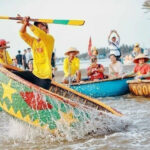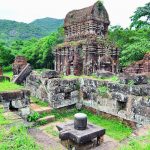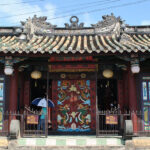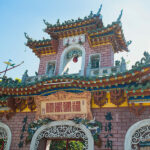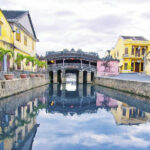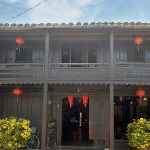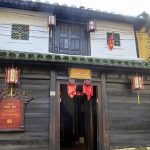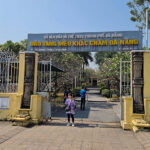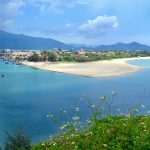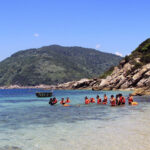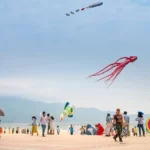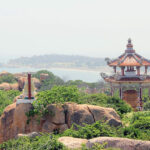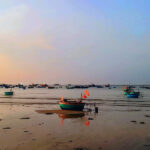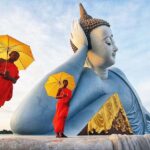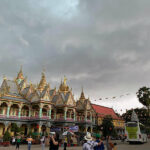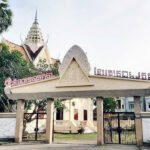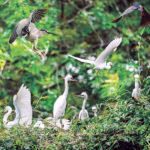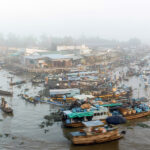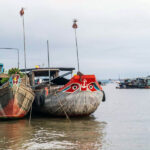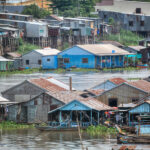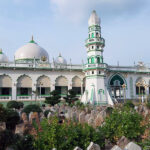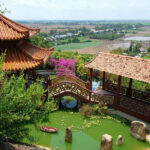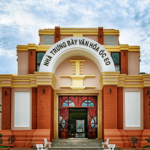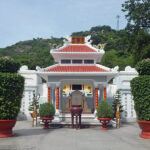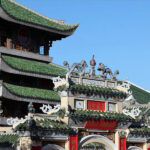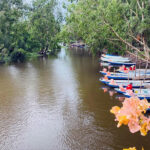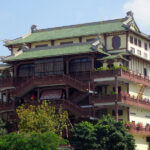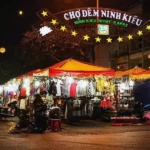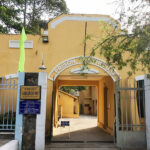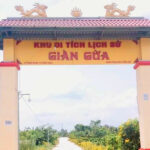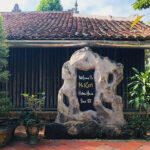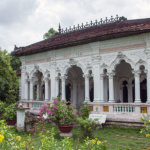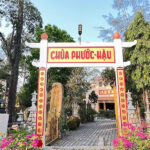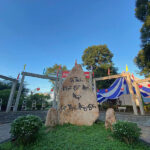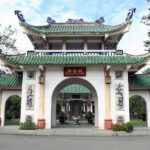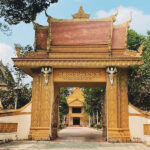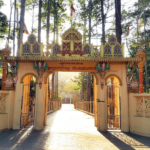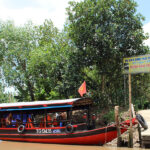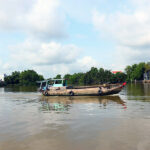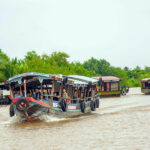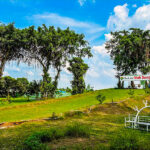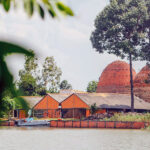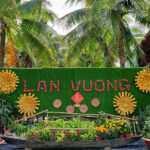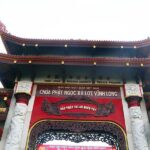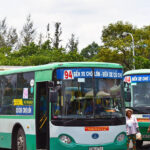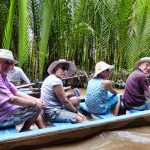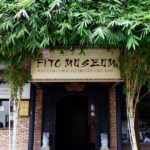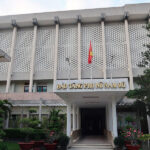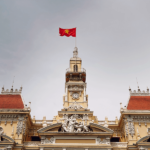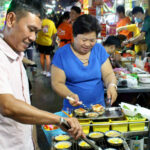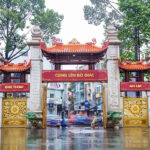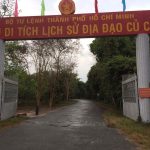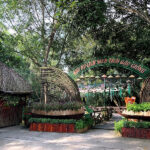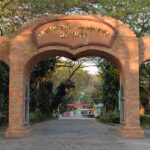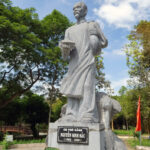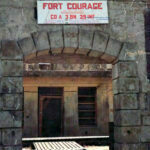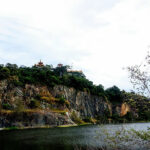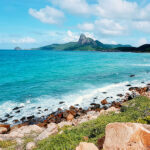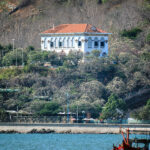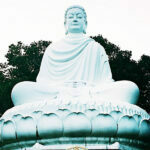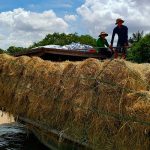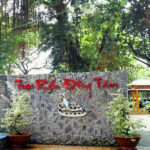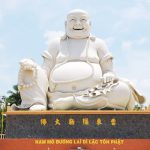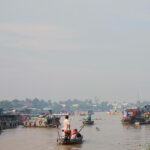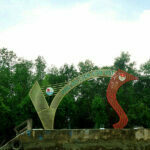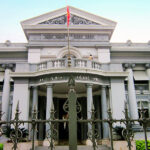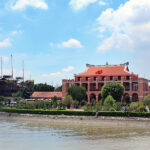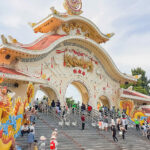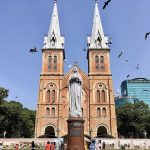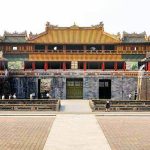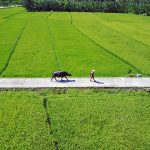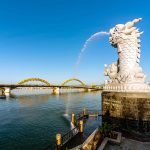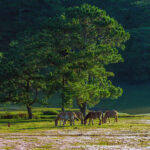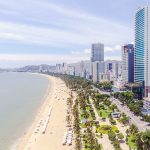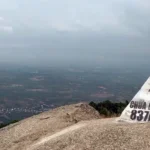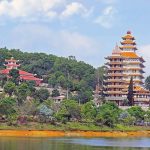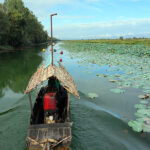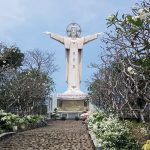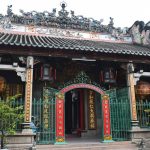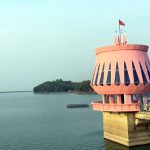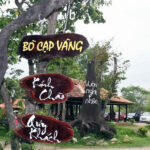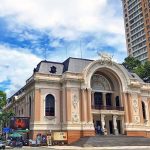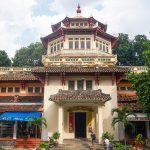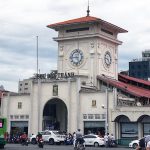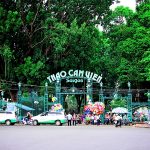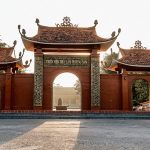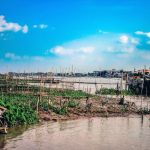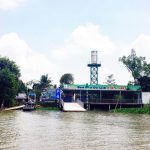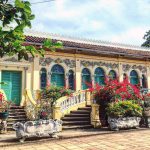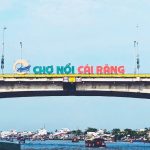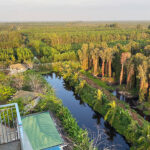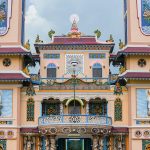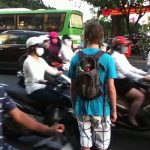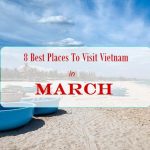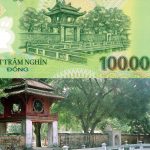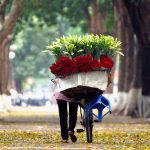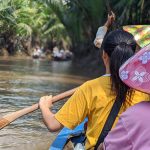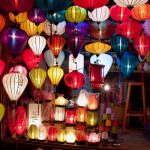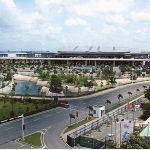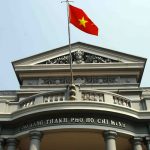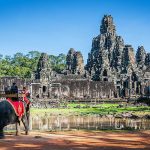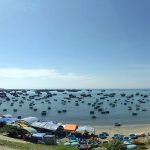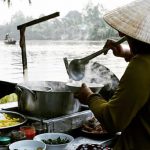Tuyen Quang is a province with rich tourism potential because of its diverse and rich culture, with many historical and cultural relics along with a unique forest ecosystem combined with rivers, lakes, mountains, and hills creating many beautiful landscapes. With many types of tourism, notably historical tourism, ecological tourism, resort tourism, community tourism… exploring Tuyen Quang is a favorite choice of many tourists.
Table of Contents
General information about Tuyen Quang
Tuyen Quang is located in the Northeast region, bordering China to the north, Thai Nguyen to the east, Lao Cai to the west, and Phu Tho to the south. After merging with Ha Giang, Tuyen Quang province has a total area of 13,796 km². Tuyen Quang is the extreme point of the country with famous landscapes such as: Lung Cu Flagpole, Ma Pi Leng Pass – one of the four great mountain passes of Vietnam.

In addition, during the August Revolution, Tuyen Quang was the capital of the liberated zone, chosen as the revolutionary center of Vietnam. In places like Tan Trao – Son Duong – Tuyen Quang, many historical events took place. Today, Tuyen Quang is considered a rich tourist destination, combining historical learning and experiencing nature.
What’s the best time to visit Tuyen Quang?
Being a mountainous province, the climate in Tuyen Quang is distinctly cold compared to the neighboring lowlands and midlands. The average annual temperature is about 21-23 degrees Celsius. The climate is characterized by high humidity throughout the year, heavy and prolonged rain.

You can travel to Tuyen Quang at any time of the year, but most tourists often come to Ha Giang in the autumn when the rice is golden. The most beautiful time is October, November and December, when buckwheat flowers or mustard fields are in full bloom.

In spring, apricot and plum flowers bloom white in the forest, making you feel like you are floating on clouds. In May, the rice fields sparkle in the pouring water season. In June and July, many people miss Tuyen Quang because of the sudden summer rains. But thanks to this humidity, the mountains and forests here are covered with a captivating green color.
How to get there?
The center of Tuyen Quang is about 125 km from the center of Hanoi. The fastest way is to follow the Noi Bai – Lao Cai highway and then onto the Tuyen Quang – Phu Tho highway. The entire route takes about 2 hours.
Tourist buses from Hanoi to Tuyen Quang depart from My Dinh, Giap Bat, Luong Yen, Yen Nghia, Gia Lam stations. The travel time is about 2 and a half hours. Tourists can choose a sleeper bus or a high-quality limousine, depending on your finances. However, you should travel by night bus to save time and save energy for a long journey of discovery. The ticket price from Hanoi to Tuyen Quang and vice versa ranges from 200,000 – 300,000 VND one way.
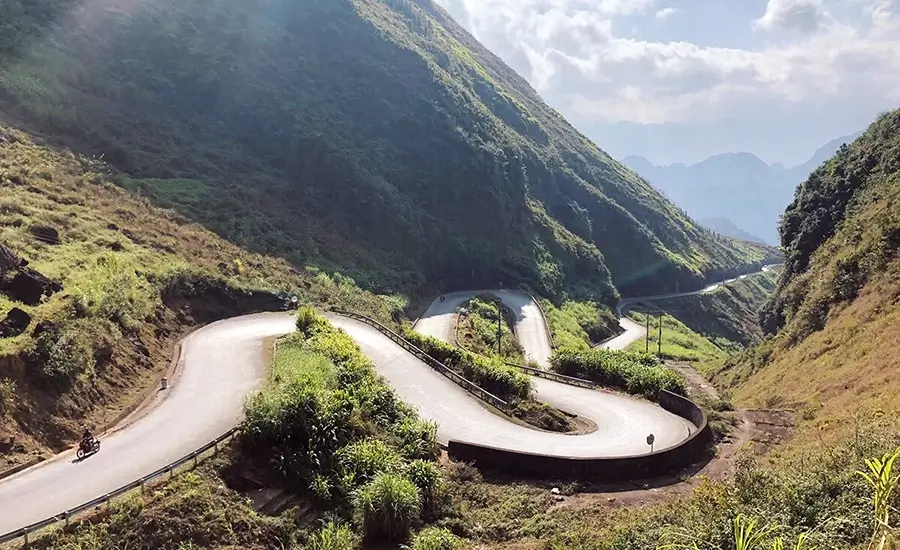
Ma Pi Leng Pass (photo source: collected)
When arriving in Tuyen Quang, you can rent a motorbike to travel by yourself for 150,000 – 300,000 VND per motorbike per day. On the contrary, if you do not have enough time and health, or if your group includes elderly people and children, you should book a private car to Tuyen Quang.
Accommodations in Tuyen Quang
There are many hotels and motels in the center of Tuyen Quang. If visitors only go to places less than 100 km away, they should stay in the city. Muong Thanh Tuyen Quang Hotel has prices ranging from 1 to 1.3 million VND per night, Royal Palace is about 800,000 VND per night. Smaller hotels cost from 300,000 to 600,000 VND such as Anh Anh Luxury Hotel, Tan Trang Hotel, Kim Long Hotel, Nang Mai Hotel.
The Minh Ngoc and Ngoc Duong areas have many high-end, separate resorts suitable for families or couples. Here, visitors can immerse themselves in the colors of the highlands by the longest brocade road in Vietnam, staying in villas with the design of H’Mong houses. The price for a night’s stay is about 10,000,000 VND.
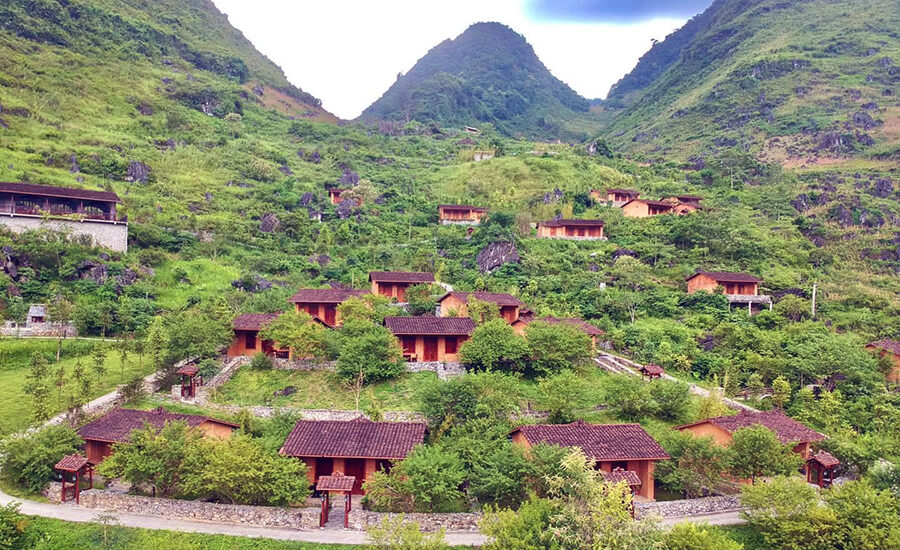
H’Mong village resort (photo source: booking).
For visitors who love novelty, H’Mong Village with its drum-shaped design is a suggestion. The resort is located on the hills of Trang Kim, Quan Ba, facing the Mien River and the majestic mountains in the distance. Visitors can choose to stay in a communal room, priced at 400,000 VND per night or in a bungalow for 2,400,000 VND per night.

A view from P’apiu resort (source: booking).
With options closer to the community and lower costs, visitors can stay at homestays, including Hoang Su Phi Lodge and Kinh Homestay in Hoang Su Phi, next to the terraced fields in Nam Hong village; Ho Thau Eco Village in Ho Thau commune with a thatched-roof rammed earth house resort.

A view of Hoang Su Phi Lodge (source: booking).
In addition, you can stay at Chung Pua – Auberge de MeoVac (Meo Vac) with a local-style earthen house or Bui homestay, a stilt house in Dong Van. In Dong Van, there is also Hoang Than ancient house priced at 100,000 VND per person; Ong Vang Meo Vac priced at only 230,000 VND per night. In Lo Lo Chai village near Lung Cu flagpole, there is Lo Lo Ancient House homestay.
In Na Hang, visitors can choose homestays such as Ban Ne Thanh Tuong homestay, A Phu homestay, Deo But Na Hang homestay (Misa), Khuoi Nhi homestay, Hung Hoa homestay Na Hang, Hoang Viet homestay. These places all have full-service accommodation and meals. The price per person per night is about 200,000 VND per person/1 night.
Tourist attractions in Tuyen Quang
Historical and cultural relics
Tuyen Quang has 546 historical, cultural and scenic sites, of which 435 are considered the “Revolutionary Museum” of the whole country.
Tan Trao historical site
Tan Trao is a commune associated with President Ho Chi Minh. The commune has 17 relics, recording historical events in the early days of the country’s founding, such as Na Lua hut, Tan Trao banyan tree, Tan Trao communal house, Hong Thai communal house, along with places marking the 9-year resistance war.
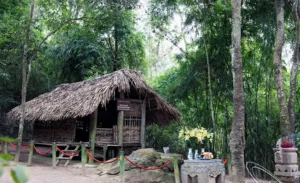 Na Lua hut is a small hut, located on the slope of Na Nua mountain, nearly 1 km east of Tan Lap village. Na Nua hut is built of bamboo in the half-floor, half-ground style of the mountain people, under dense trees. This is where President Ho Chi Minh lived and worked from the end of May to the end of August 1945 to prepare for the general uprising. The hut was built of bamboo in the style of a stilt house. On June 4, 1945, President Ho Chi Minh convened a conference of cadres to prepare for the establishment of a “liberated zone, liberation army”, leading to the National Congress and the general uprising. The hut is still preserved and is a famous tourist destination for visitors to Tuyen Quang.
Na Lua hut is a small hut, located on the slope of Na Nua mountain, nearly 1 km east of Tan Lap village. Na Nua hut is built of bamboo in the half-floor, half-ground style of the mountain people, under dense trees. This is where President Ho Chi Minh lived and worked from the end of May to the end of August 1945 to prepare for the general uprising. The hut was built of bamboo in the style of a stilt house. On June 4, 1945, President Ho Chi Minh convened a conference of cadres to prepare for the establishment of a “liberated zone, liberation army”, leading to the National Congress and the general uprising. The hut is still preserved and is a famous tourist destination for visitors to Tuyen Quang.
Tan Trao Banyan Tree: Under the banyan tree of Tan Lap village, on the afternoon of August 16, 1945, the Vietnamese Liberation Army held a departure ceremony witnessed by the people of Tan Trao and 60 national delegates attending the National Congress. General Vo Nguyen Giap read the first military order and then the Liberation Army set off through Thai Nguyen to liberate Hanoi.
 Tan Trao Communal House: this is the communal house worshipping the village’s tutelary god and the river and mountain gods of Tan Lap village. The communal house was built in 1923 in the style of a stilt house, with wooden pillars, 3 rooms, 2 wings, and a roof covered with palm leaves. Here, on August 16, 1945, the delegates of the National Congress approved the policy of carrying out the General Uprising, stipulated that the national flag was the red flag with a yellow star, the national anthem was the Tien Quan Ca and elected the National Liberation Committee (Provisional Government) headed by President Ho Chi Minh. On the morning of August 17, 1945, President Ho Chi Minh read the oath at the National Introduction Ceremony here.
Tan Trao Communal House: this is the communal house worshipping the village’s tutelary god and the river and mountain gods of Tan Lap village. The communal house was built in 1923 in the style of a stilt house, with wooden pillars, 3 rooms, 2 wings, and a roof covered with palm leaves. Here, on August 16, 1945, the delegates of the National Congress approved the policy of carrying out the General Uprising, stipulated that the national flag was the red flag with a yellow star, the national anthem was the Tien Quan Ca and elected the National Liberation Committee (Provisional Government) headed by President Ho Chi Minh. On the morning of August 17, 1945, President Ho Chi Minh read the oath at the National Introduction Ceremony here.
 Hang Bong hut: located halfway up Bong Mountain, at the foot of the mountain is the Pho Day River winding around the right side of the mountain range. This is where President Ho Chi Minh lived and worked during the resistance war against the French from 1950 – 1951. On 22 February 1950, he signed a decree to mobilise people resources for resistance war. On 25 July 1950, he answered questions raised by jourmalists on the interference of America in the independence of Indochina. Also, from this cave, Uncle Ho directed the border campaign of 1950 and participated in the second National Party Congress in 1951.
Hang Bong hut: located halfway up Bong Mountain, at the foot of the mountain is the Pho Day River winding around the right side of the mountain range. This is where President Ho Chi Minh lived and worked during the resistance war against the French from 1950 – 1951. On 22 February 1950, he signed a decree to mobilise people resources for resistance war. On 25 July 1950, he answered questions raised by jourmalists on the interference of America in the independence of Indochina. Also, from this cave, Uncle Ho directed the border campaign of 1950 and participated in the second National Party Congress in 1951.
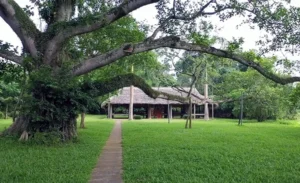 Hong Thai Communal House: before 1945, the communal house was called Kim Tran, located in Kim Tran village (now Ca village), later named after martyr Pham Hong Thai. The communal house was built in 1919, with wooden architecture, palm-leaf roof, including 3 rooms and 2 wings, in the shape of a mountain stilt house. The communal house worships the village’s Thanh Hoang, the river god, the mountain god and the gods around the area. In addition, the communal house also worships Princess Ngoc Dung. This is also a place for cultural activities and meetings of the village. In addition to its religious value, the communal house also has historical value because it was the first stop for President Ho Chi Minh after returning from Pac Bo (Cao Bang) to Tan Trao on May 21, 1945.
Hong Thai Communal House: before 1945, the communal house was called Kim Tran, located in Kim Tran village (now Ca village), later named after martyr Pham Hong Thai. The communal house was built in 1919, with wooden architecture, palm-leaf roof, including 3 rooms and 2 wings, in the shape of a mountain stilt house. The communal house worships the village’s Thanh Hoang, the river god, the mountain god and the gods around the area. In addition, the communal house also worships Princess Ngoc Dung. This is also a place for cultural activities and meetings of the village. In addition to its religious value, the communal house also has historical value because it was the first stop for President Ho Chi Minh after returning from Pac Bo (Cao Bang) to Tan Trao on May 21, 1945.
Mac Dynasty Citadel
Mac Dynasty Citadel is located in Minh Xuan Ward. The citadel was built in 1592, during the Mac Dynasty and was repaired in the early Nguyen Dynasty (19th century). The citadel has an important military position, guarding the banks of the Lo River and 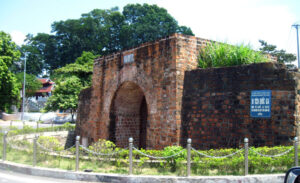 located on the waterway and road traffic axis, and has been associated with many important historical events.
located on the waterway and road traffic axis, and has been associated with many important historical events.
The citadel is an architectural and artistic relic, and is also the site of many battles of peasant uprisings, battles against the French and Japanese, and the place where President Ho Chi Minh spoke to the people of Tuyen Quang when he returned to visit after 6 years of absence. The citadel is no longer intact but still retains its basic parts, and is a symbol of Tuyen Quang’s history. Recently, the citadel has been restored and some items such as the two gates and the remaining 140 meters of wall have been repaired.
Vuong’s villa
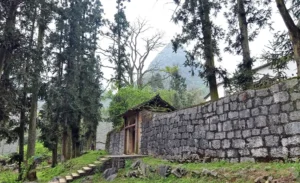 Vuong’s Villa (Vuong Chi Sinh) is an interesting tourist site, 24km from the town of Dong Van, in the locality of Sa Phin Commune. It is not large but its original architectural is unique in the highlands. The road sloping in front of the villa is paved with big, smooth, square stones and the villa is surrounded by two walls built from carved stones.
Vuong’s Villa (Vuong Chi Sinh) is an interesting tourist site, 24km from the town of Dong Van, in the locality of Sa Phin Commune. It is not large but its original architectural is unique in the highlands. The road sloping in front of the villa is paved with big, smooth, square stones and the villa is surrounded by two walls built from carved stones.
The outer wall is 60cm thick and 2m high. The inner wall is even ticker and more robust. In between the walls, there is a 50m-wide expanse of land planted oleanders.
 The villa includes 10 houses, 6 of them face the same direction, and the remains face the other directions. The main house, the largest looks out to the entrance. The other two face each other, making right angles with the main house. Every pillar, floor and wattle of these three houses are built of po-mu, a valuable wood. In the main house which was the house where the Vuong leader lived, there is a hanging horizontal tablet engraved with the four words bien chinh kha phong (remarks of great honour for contribution in the war), which was presented by the Nguyen Kings. The other two houses were used for servants and guardsmen.
The villa includes 10 houses, 6 of them face the same direction, and the remains face the other directions. The main house, the largest looks out to the entrance. The other two face each other, making right angles with the main house. Every pillar, floor and wattle of these three houses are built of po-mu, a valuable wood. In the main house which was the house where the Vuong leader lived, there is a hanging horizontal tablet engraved with the four words bien chinh kha phong (remarks of great honour for contribution in the war), which was presented by the Nguyen Kings. The other two houses were used for servants and guardsmen.
Love market of Khau Vai
 Once a year, on the 27th of the 3rd lunar month, the love market is held in Khau Vai Commune. A local myth tells story of a young couple from different tribes who fell in love with each other. The girl was so beautiful that her tribe did not want to let her get married to a man from another tribe. Consequently, violent conflict arose between the two tribes. One day, the boy witnessed an aggressive fight between the tribes as a result of their love. To stop blood from being spilt, the lovers sorrowfully decided to say goodbye. However, they made plans to meet once a year on that day.
Once a year, on the 27th of the 3rd lunar month, the love market is held in Khau Vai Commune. A local myth tells story of a young couple from different tribes who fell in love with each other. The girl was so beautiful that her tribe did not want to let her get married to a man from another tribe. Consequently, violent conflict arose between the two tribes. One day, the boy witnessed an aggressive fight between the tribes as a result of their love. To stop blood from being spilt, the lovers sorrowfully decided to say goodbye. However, they made plans to meet once a year on that day.
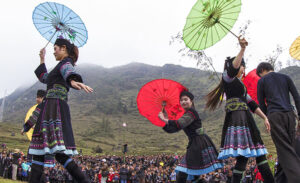 The place where they used to meet is Khau Vai. After time, Khau Vai, thereafter, became a meeting place for all of those in love.
The place where they used to meet is Khau Vai. After time, Khau Vai, thereafter, became a meeting place for all of those in love.
The Lover Market used to involve no sellers buyers at the beginning. All those who came here came to pursue their missing love. If by chance they met an “old flame” they would spend time talking intimately. If they did not, they would make friends with a stranger of any age. They brought ready-made foods, like loaves of sticky rice, manioc and pieces of cake which they would share with their lovers.
This was an enjoyable time for all. People from remote arears would come to Khai Vai one the day before the market, so that the next morning they could be already there. Having waited for this moment for a full year, everybody went eagerly to the market.  Early in the morning, whether they were old or new comers, they would hurriedly look for their friend. If they found them, they would talk endlessly; if not, they would wait, becoming increasingly anxious and expectant. In the afternoon, all the lovers were sad because it was time to say goodbye. Some couples would get married over the year, while others would plan to meet at the same time the following year.
Early in the morning, whether they were old or new comers, they would hurriedly look for their friend. If they found them, they would talk endlessly; if not, they would wait, becoming increasingly anxious and expectant. In the afternoon, all the lovers were sad because it was time to say goodbye. Some couples would get married over the year, while others would plan to meet at the same time the following year.
For the past years, as there is an increasing demand to make a living, people bring goods to sell at the market. Thus, you can go to Khau Vai to trade two kinds of specialties: goods and feelings. Even today, Khau Vai Love Market echoes back to the past as it carries on the tradition set by its mythical love story.
Nature and wildlife areas
Favored by nature, Tuyen Quang has many majestic landscapes and many cultural features of the nation.
Na Hang Primitive Forest
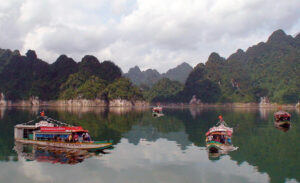 Na Hang Primitive Forest is contiguous to Ba Be Lake, a famous tourist attraction in the North. The whole area has a total area of 15,000 hectares, of which more than 8,000 hectares are lake water surface. It unfolds a quite thick vegetation cover and over 1,000 plant species, including rare and valuable one such as the dinh, mun (ebony trees), sen (bassia).
Na Hang Primitive Forest is contiguous to Ba Be Lake, a famous tourist attraction in the North. The whole area has a total area of 15,000 hectares, of which more than 8,000 hectares are lake water surface. It unfolds a quite thick vegetation cover and over 1,000 plant species, including rare and valuable one such as the dinh, mun (ebony trees), sen (bassia).
It home to 79 animal species such as tiger, panther, flying weasel, flying squirrel, bear, antelope, deer, ape, and so on. Especially, its upturned-noised money (Rhinopithecus Avunculus) has been listed in the World Red Book. The forest also shelters 263 winged animal species such as 35 frog species, 25 reptile species, and over 500 insect species.
 The road is also very beautiful, winding around the mountains and hills. Visitors will have a large space to explore and relax, especially cruising on the lake. Boats on the lake operate from 8am to 5pm every day.
The road is also very beautiful, winding around the mountains and hills. Visitors will have a large space to explore and relax, especially cruising on the lake. Boats on the lake operate from 8am to 5pm every day.
Another interesting experience is trekking in the primeval forests of Na Hang to visit Pac Ta Temple, explore beautiful caves such as: Bo Kim cave (Thanh Tuong commune), Khau Quang cave (Nang Kha commune), Phia Muon cave (Son Phu commune), Khuoi Pin cave (Khuon Ha commune)…and waterfalls wsuch as Nam Me waterfall (Khuon Ha commune), Khuoi Nhi waterfall (Thuong Lam commune), Mo waterfall (Na Hang town), Khuoi Nhi waterfall.
My Lam Mineral Spring
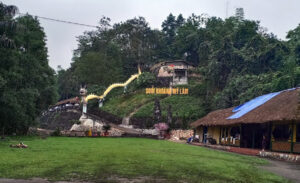 My Lam Mineral Spring is located 12 km southwest of Tuyen Quang centre, a key tourist area of the province. My Lam natural mineral water was discovered by French geologists in 1923, is clear and hot, always stable at 67 degrees Celsius, taken directly from an underground water source more than 150 m deep. It also contains sulphur magnesium, calcium other minerals with therapeutic qualities.
My Lam Mineral Spring is located 12 km southwest of Tuyen Quang centre, a key tourist area of the province. My Lam natural mineral water was discovered by French geologists in 1923, is clear and hot, always stable at 67 degrees Celsius, taken directly from an underground water source more than 150 m deep. It also contains sulphur magnesium, calcium other minerals with therapeutic qualities.
The tourist area has a full system of hotels and restaurants, meeting the diverse needs of visitors when they come to experience.
Mo Waterfall
 Mo Waterfall (also known as Pac Ban Waterfall) is nearly 100 km from Tuyen Quang center. The road to Mo waterfall is convenient. Once can hear the noise of water pouring far from above. The closer visitors draw to the waterfall, the cooler they feel. It seems as if visitors were in a fairy land when they stand in front of the waterfall. Its water pours into the lake lying at the foot of the mountain.
Mo Waterfall (also known as Pac Ban Waterfall) is nearly 100 km from Tuyen Quang center. The road to Mo waterfall is convenient. Once can hear the noise of water pouring far from above. The closer visitors draw to the waterfall, the cooler they feel. It seems as if visitors were in a fairy land when they stand in front of the waterfall. Its water pours into the lake lying at the foot of the mountain.
There are two ways to visit Mo Waterfall. If tourists want to take it easy and spend less effort, they should go by boat and admire the picturesque setting around it. Those who like adventure and want to have more points of contact can approach by road.
The waterfall with the silver hues is composed for 3 layers. To reach the second layer, visitors have to climb up 100m by a rope ladder. At the foot of the second layer, there is small and pure lake. Here, visitors will see the imposing landscape with the caves,  which have beautiful stalactites and stalagmites. The water flows slowly through the green moss-covered rocks which look like a velvet rug. Keeping the climbing, visitors will reach the third layer. Water pour very strongly. The coolness of water seems to drive back the exhaustion of visitors and to bring about a new feeling for them when they stand at the top to have a panoramic view of Na Hang town which is surrounded by 99 mountains.
which have beautiful stalactites and stalagmites. The water flows slowly through the green moss-covered rocks which look like a velvet rug. Keeping the climbing, visitors will reach the third layer. Water pour very strongly. The coolness of water seems to drive back the exhaustion of visitors and to bring about a new feeling for them when they stand at the top to have a panoramic view of Na Hang town which is surrounded by 99 mountains.
In addition, tourists can freely visit the primeval forest surrounding the waterfall. Tourists will be able to touch the tau trees, tall green lat trees, and giant leaf carpets. Mo waterfall is a wonderful ecological tourist attraction in Tuyen Quang which is welcome those who like adventures.
Ban Ba Waterfall
Ban Ba Waterfall is located on the slope of Phieng Khang mountain, in Trung Ha commune, 70 km from Tuyen Quang center. From Chiem Hoa, the small road turns into the waterfall, 25 km long, deep in the forest. The waterfall is uniquely  beautiful because of the chain of waterfalls, with three large waterfalls including Tat Cum, Tat Cao, Tat Gio. The transitions between the waterfalls are small waterfalls with a height of 5-7 m, with many small streams and clear water pools.
beautiful because of the chain of waterfalls, with three large waterfalls including Tat Cum, Tat Cao, Tat Gio. The transitions between the waterfalls are small waterfalls with a height of 5-7 m, with many small streams and clear water pools.
Coming to Ban Ba, tourists can also explore the old forest with hundreds of years old trees, many precious woods, and climbing plants. At the foot of the waterfall, the lush fields all year round create a beautiful natural picture. If visitors want to find a place to rest, they should choose a stilt house of the ethnic people and enjoy rau don, hill chicken, grilled fish, and rocket pig.
Tien cave
Located halfway up Pu Phia mountain, Tien cave (Chi village, Xuan Giang commune) is about 265m above sea level, with a northeast facing entrance. The local Tay people call it Pu Phia (Pu is cave, Phia is stone, meaning stone cave); Common name: Tien 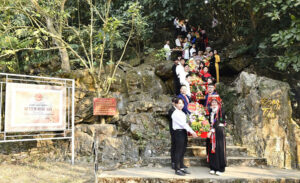 cave (meaning: Tien cave is a beautiful cave, a place where fairies live). Tien cave was discovered by local people several decades ago. The cave was formed in the heart of a limestone mountain mixed with soil, a dry cave, with 01 cave entrance and 02 compartments.
cave (meaning: Tien cave is a beautiful cave, a place where fairies live). Tien cave was discovered by local people several decades ago. The cave was formed in the heart of a limestone mountain mixed with soil, a dry cave, with 01 cave entrance and 02 compartments.
Tien cave is located in the heart of a mountain range of soil mixed with limestone and covered with forest. The cave was formed by the geological tectonic process (Karst). The cave is connected to the outside by a single entrance, the inside of the cave has a dome shape, stalactites appear densely throughout the walls and ceiling of the cave, many stalactite columns stretch from the ceiling down to the cave floor. The stalactites in the cave are kept intact, untouched by human hands.
Dong Van Highland
Dong Van highland, situated 146km from the town of Ha Giang and 1000m above sea level, is inhabited by the Tay and H’Mong ethnic groups. It takes about nine hours to reach this area by car from the town of Ha Giang. The temperature is approximately 1C 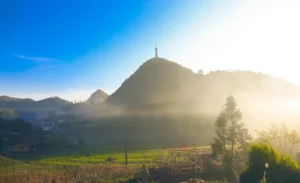 in winter and reaches 24ºC on the hottest days. Dong Van has a lot to offer including mountains, forests, hidden grottoes and caves, multicolored orchid forests and fruit orchards. The plateau provides famous products and fruits such as Hau plums, peaches, persimmons without seeds and apples. There are also numerous plants used for their medicinal value, ginseng, anise, cinnamon, etc…
in winter and reaches 24ºC on the hottest days. Dong Van has a lot to offer including mountains, forests, hidden grottoes and caves, multicolored orchid forests and fruit orchards. The plateau provides famous products and fruits such as Hau plums, peaches, persimmons without seeds and apples. There are also numerous plants used for their medicinal value, ginseng, anise, cinnamon, etc…
Also interesting to visit is Pho Bang which features old multi-story houses made of clay bricks and tile roofs. On Sundays, all kinds of goods and multicolored clothes can be purchased in a very original mountain market.
Specialities of Tuyen Quang
Fish Salad of Lo river
 This is the first dish to enjoy after arriving in Tuyen Quang. The fish used to make salad is phoenix barb, also know as Chinese phoenix barb. The fish has very firm, delicious and healthy meat, no fishy smell, and has high nutritional value. The fish meat contains a lot of protein, vitamins, minerals, … which are very good for health.
This is the first dish to enjoy after arriving in Tuyen Quang. The fish used to make salad is phoenix barb, also know as Chinese phoenix barb. The fish has very firm, delicious and healthy meat, no fishy smell, and has high nutritional value. The fish meat contains a lot of protein, vitamins, minerals, … which are very good for health.
The fish can be processed into many delicious dishes such as salad, grilled, sour soup, … However, the fish salad is the most popular dish. The fish salad is made from fresh fish meat, combined with herbs and spices such as lemon leaves, perilla, galangal, ginger, lemon juice, … creating a dish with a delicious flavor, sour, spicy, salty and sweet, making it difficult for anyone who has enjoyed it once to forget.
Steamed Ke flower with meat
Steamed Ke flower with meat is a typical dish of the Tay ethnic group. The Ke flower is a wild flower that grows in the forest, usually reddish-brown in color, grows in clusters and has a characteristic bitter taste. After removing the pistil and washing, local  people often mince the meat mixed with fat, add some fresh onions, wood ear mushrooms, ground pepper, spices, all mixed well with eggs. The Ke flower is shaped like a small bell, so the stuffing process is very quick and simple. When finished stuffing, the flower is steamed for about 15 minutes. The blooming flowers with soft, fatty meat filling seem to awaken the sense of smell of the person enjoying it. Steamed Ke flower with meat is served hot, dipped in a little fish sauce, the bitter taste on the tip of the tongue quickly passes, replaced by the strange sweetness of the Ke flower, the sweet and fatty taste of eggs, meat, and a little spicy of ground pepper to warm the heart on early winter days..
people often mince the meat mixed with fat, add some fresh onions, wood ear mushrooms, ground pepper, spices, all mixed well with eggs. The Ke flower is shaped like a small bell, so the stuffing process is very quick and simple. When finished stuffing, the flower is steamed for about 15 minutes. The blooming flowers with soft, fatty meat filling seem to awaken the sense of smell of the person enjoying it. Steamed Ke flower with meat is served hot, dipped in a little fish sauce, the bitter taste on the tip of the tongue quickly passes, replaced by the strange sweetness of the Ke flower, the sweet and fatty taste of eggs, meat, and a little spicy of ground pepper to warm the heart on early winter days..
Buffalo skin salad
 The Tay people in Lam Binh have turned buffalo skin into a specialty on the dinner table on special occasions. Buffalo skin is heated over a fire and then soaked in water. After being cleaned, it is boiled for 1.5 to 2 hours and then sliced.
The Tay people in Lam Binh have turned buffalo skin into a specialty on the dinner table on special occasions. Buffalo skin is heated over a fire and then soaked in water. After being cleaned, it is boiled for 1.5 to 2 hours and then sliced.
Buffalo skin salad needs to be seasoned with spices and herbs such as peanuts, Vietnamese coriander, mac khen (a typical spice of the Northwest mountainous region of Vietnam, with a strong aroma and unique tongue-numbing taste) and banana flowers. The sweetness of buffalo skin, the richness of roasted peanuts, and the aroma of spices combine to create a special dish.
Steamed rolled rice pancake
 In Ha Giang area, steamed rolled rice pancake is not only special in its broth, but also attracts tourists in the process of making it into a unique roll. After the cake is spread evenly on a round steamer, two eggs are beaten in and smoothed out. Then, the lid is closed and the cake and eggs are cooked evenly, giving off a fragrant aroma. Finally, the seller will add the filling made from wood ear and meat, and quickly roll it up.
In Ha Giang area, steamed rolled rice pancake is not only special in its broth, but also attracts tourists in the process of making it into a unique roll. After the cake is spread evenly on a round steamer, two eggs are beaten in and smoothed out. Then, the lid is closed and the cake and eggs are cooked evenly, giving off a fragrant aroma. Finally, the seller will add the filling made from wood ear and meat, and quickly roll it up.
At this point, the cake will have a unique light yellow color. The taste of the outer layer of cake, along with the fatty taste of eggs and the sweet broth, creates an attraction, attracting locals and tourists.
Na Hang Corn Wine
Known for its rich flavor of the ethnic minorities in the northern mountainous region, Na Hang corn wine is a famous delicacy of Tuyen Quang province. Visitors can immediately see the image of a woman making wine when entering a traditional house. Na Hang leaf yeast is the main ingredient that creates the unique flavor of this wine. Shiitake mushrooms are one of 20 herbs used to make yeast, giving this wine its unique flavor.
What to buy as a gift in Tuyen Quang?
The old Ha Giang area (currently belong to Tuyen Quang province) oranges are famous for their delicious ripe fruits with a distinct, sweet flavor that any visitor would want to bring back to relatives and friends.
Smoked sausage is made from half lean and half fat meat marinated with salt, sugar, MSG, white wine, ginger juice and a little bit of dried, crushed mac mat fruit marinated with the smell of smoke from the kitchen with a characteristic aroma that makes you remember it forever after eating it.
From September to December of the lunar calendar is the time to harvest mint honey in the Stone Plateau. Along Highway 4C to Quan Ba, Dong Van, and Meo Vac areas, visitors can easily see beekeeping huts and honey exploitation on the spot. The typical honey is lemon yellow, has a strong aroma, and is sweet and cool like mint.

Source: collected by An
Follow us for the best deal with Vietnam package tours and visa services!





